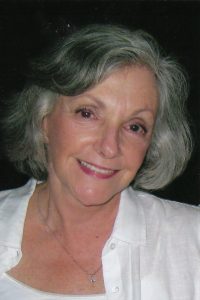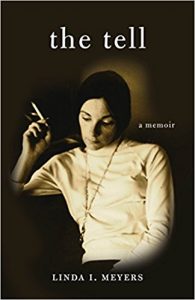Psychoanalysis and Memoir
 I am a psychologist, psychoanalyst, former patient and a writer. I have recently completed my memoir, The Tell. In thinking over these different roles I’ve come to see how much they have in common and how one naturally embraced another.
I am a psychologist, psychoanalyst, former patient and a writer. I have recently completed my memoir, The Tell. In thinking over these different roles I’ve come to see how much they have in common and how one naturally embraced another.
It was my mother’s suicide that gave me the impetus to begin college. I was twenty-eight, separated and the mother of three when I made the decision to go after what I had so longed for as a teenager. I could think of no better way to give meaning to her death than to change my life. It was no surprise that psychology had become my major, I had been an unlicensed psychologist my whole life. As a child it was imperative to try and understand the why and when and what of their behavior so that I could mitigate the fallout and to not end up collateral damage in my parents’ endless war.
After I received my doctorate in psychology I studied for seven more years to earn my certificate in psychoanalysis. For me, psychology was trying to understand what was being said but psychoanalysis was more concerned why it was being said at all.
Psychoanalysis is the only discipline that requires candidates to enter their own analytic treatment. This requirement was unnecessary for me as I had begun analysis years before. I was haunted by mother’s death. The conflicting feelings of guilt and remorse, anger and sadness had left me in deep despair. I went through my days, often with a smile on my face but inside I was filled with despair and my heart was heavy.
I had thought that my treatment would focus on the trauma of her death and that after a year—three times a week on the couch, I would walk out the door with a new lease on life. It was in the thirteenth year that I began the termination process and the fourteenth year that I left my analyst’s office for the last time.
Although I credit my analyst with giving me the sense-of-self and the courage to write my memoir, when I left treatment I had no intention of writing it at all. The writing began in the same way that the treatment began—as I mentioned previously the initial intention of the treatment was to work through the trauma of my mother’s suicide, the same could be said for the writing.
I’d only expected to write one essay and not a whole book.
The essay was Dead Serious. It took twelve pages and at least as many hours to write the story of the day she killed herself. But the essay, like the analysis, raised more questions then it answered. Just saying it wasn’t enough, it was the why of it that mattered—an excavation of the before and then an exploration into the after.
All of that was talked about in therapy but it wasn’t put together into a cohesive and coherent whole. Writing the memoir was taking all the found pieces of the puzzle, giving them a frame and then filling in the center, piece by piece. After fourteen years of psychoanalysis it was all there it just needed to be appropriately arranged.
I’m not sure which enterprise, therapy or writing, required more courage? I was not alone in therapy. I had a wonderful, smart and empathic analyst to metaphorically hold me as I recounted childhood memories and dipped down into the dark holes in my ego.
She bore witness to all I brought forth. She cheered me on and celebrated with me when I had those rare, but wonderful “a-ha” experiences but in writing memoir the only cheerleader I had was myself.
I was also alone each morning as I faced the blank page.
Critical members of my family lined up like an opposing army ready to blast holes in my emotional truth. In analysis they had an important role to play but they were interference in my writing. Most days I could eventually kick them out but that was only because of the treatment I had.
For example, I was able to channel my analyst who would question why it was that I needed my mother in the room? Was she salient to the chapter I was writing or was she there to hinder my progress? There was a joy when I could answer that question and the work would progress.
In the way that psychoanalysis and writing memoir take courage, they also take commitment. to get the desired results, you have to stick with it.
In analysis you often encounter resistance. Resistance is annoying. It thwarts progress mostly because it lives in the realm of the unconscious. A good analyst can help the patient’s unconscious to loosen its grip and free the repressed.
Writers experience resistance as writer’s block but they have only themselves to call upon to help them. As we know it can take days and sometimes weeks to give up its grasp. The well-known essayist, Fran Liebowitz suffered it for years—she called it writer’s blockade. I believe it is easier to work through with the help of an internalized analyst but in any case, it takes commitment to see it through.
In this essay I’ve contrasted and compared being in psychoanalysis with writing memoir but I don’t think I’ve been able to fully answer the question, Why did I write my memoir?
Perhaps Joan Didion had the answer. When Terry Gross on Fresh Air, asked her how it was that she was able to write The Year of Magical Thinking—the memoir about her husband, John Gregory Dunne, so soon after his death? She answered, “that it wasn’t until she saw it on the page that it became real.”
Was that true for me?
As anyone who has been in analysis and as any writer knows, the process is far from easy. When a patient gets stuck in analysis, their mind goes round and for session after session they feel as if they are getting nowhere, it is called resistance.
Resistance is not intentional, it is not the patient being uncooperative but rather a phenomena that often heralds a breakthrough—sometimes it is even the precursor to the rare but possible “aha” experience that moves the analysis forward in unpredictable ways. When this happens to the writer we call it “writer’s block.” It can go on for hours, days and sometimes weeks—the writer sits at her desk, the ideas swirl in her head but nothing coherent gets on the page and then for reasons that are unclear there, as in analysis, there is a breakthrough and the writer, for a little while, is in the flow and the story comes. And for the patient and the writer, there is great relief and even joy.
—
Linda I. Meyers is a psychologist and psychoanalyst in New York City and Princeton, N.J. She is the author of “The Tell.” For more information, visit http://thetellamemoir.com/
About THE TELL
 Linda I. Meyers was twenty-eight and the mother of three little boys when her mother, after a lifetime of threats, killed herself. Staggered by conflicting feelings of relief and remorse, Linda believed that the best way to give meaning to her mother’s death was to make changes to her own life. Bolstered by the women’s movement of the seventies, she left her marriage, went to college, started a successful family acting business, and established a fulfilling career.
Linda I. Meyers was twenty-eight and the mother of three little boys when her mother, after a lifetime of threats, killed herself. Staggered by conflicting feelings of relief and remorse, Linda believed that the best way to give meaning to her mother’s death was to make changes to her own life. Bolstered by the women’s movement of the seventies, she left her marriage, went to college, started a successful family acting business, and established a fulfilling career.
Written with irony and humor and sprinkled with Yiddish, The Tell is one woman’s inspirational story of before and after, and ultimately of emancipation and purpose.
Facebook – https://www.facebook.com/
IndieBound – https://www.indiebound.org/
Amazon – https://www.amazon.com/Tell-
Barnes and Noble – https://www.barnesandnoble.
Books-a-Million – http://www.booksamillion.com/
Category: Contemporary Women Writers, On Writing

























